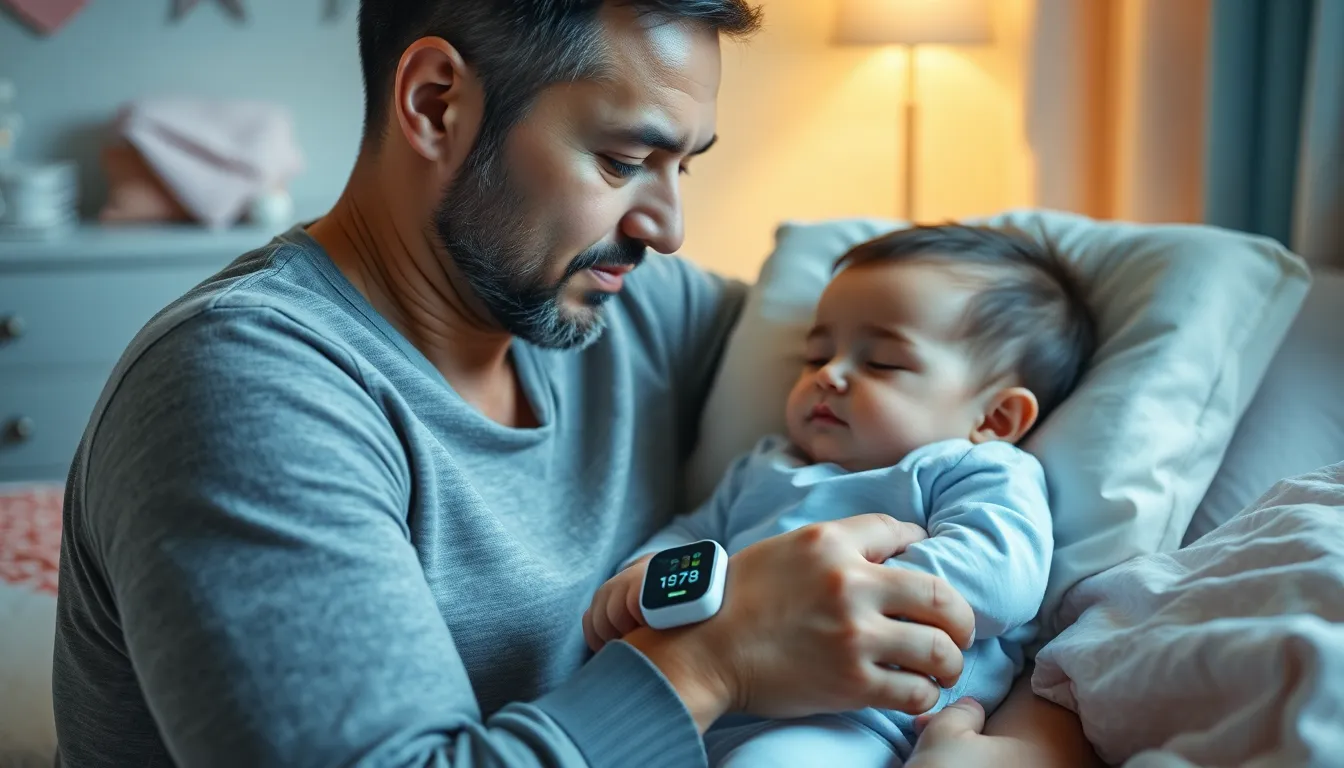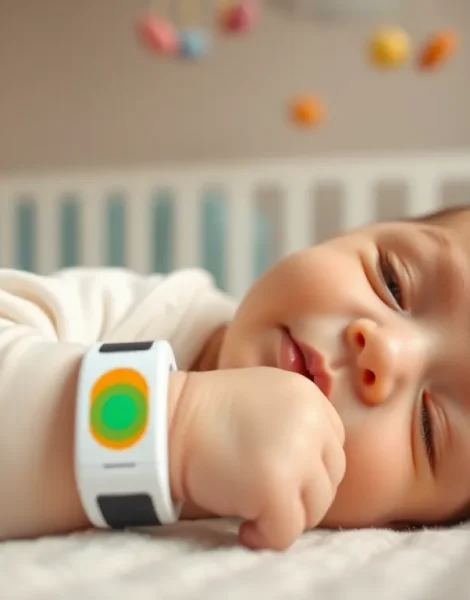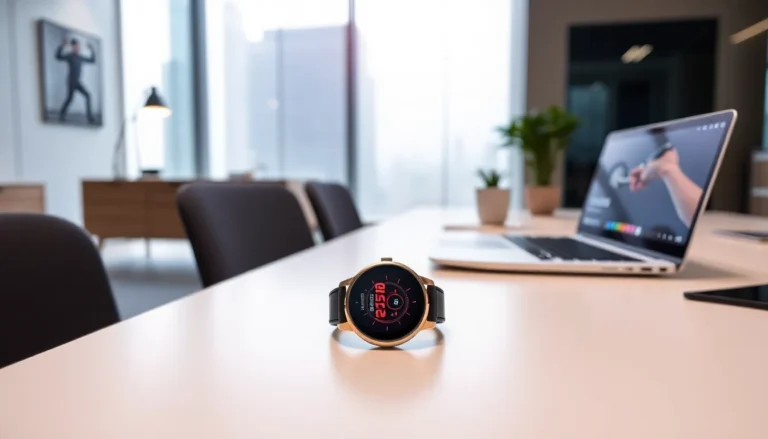In a world where every heartbeat counts, keeping tabs on an infant’s vitals has never been more crucial—or more high-tech. Enter infant vitals wearables, the adorable gadgets that promise to turn even the most anxious parent into a laid-back superhero. Imagine a tiny wristband that tracks everything from heart rate to oxygen levels, all while your little one giggles and coos, blissfully unaware of their newfound tech-savvy status.
Table of Contents
ToggleOverview of Infant Vitals Wearables
Infant vitals wearables encompass a range of devices designed to monitor health metrics in infants. These wearables typically track heart rate, oxygen saturation, and respiratory rates. Parents can receive real-time updates through smartphone applications, ensuring continuous monitoring without disturbing the baby.
Various manufacturers offer these innovative gadgets in the form of wristbands, patches, and clips, each designed to suit different needs and preferences. For example, some wearables use soft materials to ensure comfort while remaining secure. Multiple devices also come equipped with alert systems that notify caregivers if any vital signs fall outside of normal ranges.
Integration with mobile technology represents a significant advancement in monitoring infant health. Data collected by these devices can help identify potential health issues early, allowing for timely intervention. Parents appreciate this proactive approach, as it alleviates anxiety associated with sudden health changes.
Durability and battery life are essential features to consider when choosing a wearable. Many products are designed to withstand the rigors of daily infant activity, providing extended usage periods. Options with rechargeable batteries enable convenience for parents who seek ease of use.
The market for infant vitals wearables continues to grow, reflecting increased awareness of infant health monitoring. New innovations consistently emerge, improving the accuracy and functionality of these products. As technology advances, caregivers gain access to better tools that enhance their ability to nurture and protect their infants’ well-being.
Importance of Monitoring Infant Vitals

Monitoring infant vitals plays a crucial role in ensuring their health and safety. Wearable technology allows parents to track vital signs conveniently, enhancing peace of mind.
Key Vital Signs to Track
Heart rate serves as a primary indicator of an infant’s health. Oxygen saturation levels provide insights into respiratory function. Tracking respiratory rates is essential for identifying potential issues early. Monitoring these key vital signs helps parents stay informed and react quickly to any changes.
Benefits of Early Detection
Early detection of health concerns can significantly impact an infant’s well-being. Identifying irregularities in vital signs allows for prompt medical intervention. Rapid response to changes in heart rate or oxygen levels often results in better health outcomes. Parents benefit from reduced anxiety, knowing they can monitor their children effectively with wearable technology.
Types of Infant Vitals Wearables
Infant vitals wearables come in various forms, each designed to monitor health metrics effectively. These gadgets offer flexibility and comfort for both parents and infants.
Wearable Devices Overview
Many options exist for wearable devices, including wristbands, patches, and clips. Wristbands frequently provide heart rate and oxygen level monitoring. Patches adhere to an infant’s skin and typically track vital signs without discomfort. Clips attach to clothing, ensuring that vital signs are monitored discreetly. Each device has unique designs catering to different preferences, making it easier for parents to choose what works best for their lifestyle.
Features to Look For
When selecting an infant vital wearable, several features deserve attention. Durability proves essential, as infants often engage in activities that may cause damage. Battery life—especially in rechargeable models—should be sufficient to last through the day. Real-time notifications keep parents informed of any vital sign changes. Some devices also offer user-friendly mobile applications, providing easy access to important data. Comfort remains a priority; materials used should be safe and gentle on an infant’s sensitive skin.
Technology Behind Infant Vitals Wearables
Infant vitals wearables utilize advanced technology to monitor health indicators effectively. This technology ensures that parents stay informed about their baby’s well-being.
Sensor Technology
Sensor technology forms the core of infant vitals wearables. These devices often use photoplethysmography for heart rate monitoring and pulse oximetry to measure oxygen saturation levels. They remain lightweight and comfortable, allowing infants to move freely. Some wearables incorporate temperature sensors, providing additional data on the infant’s health status. Innovators continuously enhance sensor accuracy, making real-time health tracking reliable. Parents appreciate the integration of multiple sensors in a single device, streamlining health monitoring without unnecessary complexity.
Data Processing and Analysis
Data processing and analysis play critical roles in transforming raw sensor data into actionable insights. Wearables continuously gather health metrics, which are sent to companion smartphone applications. This real-time data analysis helps detect any deviations from normal ranges, triggering alerts for caregivers. Advanced algorithms also track trends over time, helping identify patterns in an infant’s health. Parents benefit from user-friendly interfaces that display these insights clearly and simply. Many applications offer personalized insights, fostering informed decision-making and enhancing parents’ peace of mind about their baby’s health.
Challenges and Considerations
Monitoring an infant’s vital signs with wearables presents several challenges, particularly regarding accuracy and privacy.
Accuracy and Reliability
Accuracy and reliability remain crucial factors for these wearables. Devices must consistently measure heart rate, oxygen saturation, and respiratory rates without errors. Misleading data can lead to unnecessary parental anxiety or delayed medical intervention. Many infant vitals wearables utilize advanced sensor technology, enabling precise monitoring. However, variations in sensor placement or environmental factors can affect readings. Regular calibration and adherence to manufacturer guidelines enhance device reliability. Trusted brands often conduct rigorous testing to ensure their products meet safety and performance standards. When selecting a wearable, parents should research these aspects to feel confident in their choice.
Privacy and Data Security
Privacy and data security also warrant attention as wearables collect sensitive health information. Parents must ensure their chosen devices have strong encryption protocols. Without robust security measures, there’s potential for data breaches or unauthorized access to personal information. Many manufacturers implement strict data protection policies and compliance with regulations like HIPAA. Transparency regarding data usage also plays a vital role in building trust. Users benefit from clearly outlined terms of service that specify how information gets collected, stored, and shared. Reviewing these factors helps parents safeguard their infant’s health data while enjoying the benefits of monitoring technology.
The rise of infant vitals wearables represents a transformative shift in how parents approach their baby’s health monitoring. These devices not only provide real-time insights but also empower caregivers with the ability to respond quickly to any changes in vital signs.
As technology continues to evolve, so does the potential for improved accuracy and functionality in these wearables. Parents can expect ongoing innovations that enhance usability while ensuring their infants’ comfort and safety.
Ultimately, investing in infant vitals wearables offers peace of mind, allowing parents to focus on nurturing their little ones while staying informed about their health. Embracing this technology can lead to better health outcomes and a more proactive approach to infant care.









